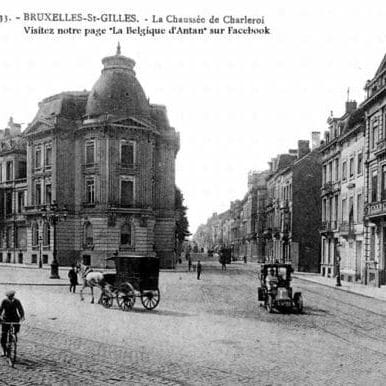Exnovation policies such as LEZs are the most effective to reduce air pollution from transport
But design matters, a study concludes
Solène Sureau and Ela Callorda Fossati
21/06/2021

A recent report highlights the effectiveness of exnovation related-policies such as LEZs to reduce air pollution, but also the importance of the design of those tools to reach the expected results. A conclusion that echoes with the results of the latest assessment of the Brussels LEZ.
The EPHA/CE Delft study: a review of impacts of transport-related policy measures
The report conducted by the independent research and consultancy CE Delft for the European Public Health Alliance (EPHA) reviews the impacts on air quality of transport-related policy measures in cities. Researchers looked at the effectiveness to reduce particulate matter (PM) and nitrogen oxide (NOx) of five policy measures implemented in cities.
Exnovation policies work best than policies supporting alternatives
Of the five policies studied in depth in the report, the three most effective in reducing PM and NOx emissions are those related to exnovation (LEZ, congestion charging and parking policies): potential reductions range from 5 to 20 % (CE Delft 2021). Exnovation related policies engage with the ‘destructive’ side of sustainability transitions rather than just with its ‘creative’ side (Kivimaa and Kern 2016). For example, they impose restrictions on the dominant mobility regime (automobility) or remove the support that it historically benefits.
On the other hand, we can distinguish policies that promote alternatives (the ‘creative’ side of mobility transitions), such as car sharing and cycling/walking policies. According to the report, those are much less effective to reduce air pollution and may even bring negative results. Those results highlight that policies aiming to phase-out unsustainable practices are needed and are complementary to policies supporting (sustainable) alternatives.
LEZs are an efficient tool, under certain conditions
The report affirms that the LEZ is the most effective measure among the five reviewed measures, with reduction levels reaching from 2% up to 23 % for NOx and up to 36 % for PM. At the same time, those figures show the uncertainties around the potential results of LEZs and the importance of the policy design for the level of effectiveness, which “depends largely on the stringency with which [LEZs] are upheld [required Euro standards] and the size of the zone » (CE Delft 2021, 5).
The Brussels LEZ, ambitious enough?
The report considers the Brussels LEZ as a “success”, with 11 % reduction in emissions of both pollutants between early 2018 and 2019, because of the “limited number of exceptions for vehicles” (CE Delft 2021, 38). Yet, it is not possible to determine the contribution of the LEZ to this reduction (since pollution levels would have decreased with the ‘natural’ fleet renewal). Also, this reduction seems weak compared to reductions obtained in other cities, such as London (RTBF 2021), where the LEZ contributed to a reduction in PM and NOx emissions by respectively 15 and 35 % (Sureau and Achten 2021).
According to the citizen association Les chercheurs d’air, this low result would originate in the access granted to pollutant powered two-wheel vehicles and trucks and to the LEZ agenda, which would be to gradual, in comparison to London and Paris (Les chercheurs d’air 2021). Central London allows access to most recent Euro-6 diesel vehicles only since 2019 (and since 2021 on a much broader area) and Paris will ban the use of all diesel vehicles in 2024. In Brussels, the access of most diesel vehicles (of Euro 5 and 6 Standards) is not restricted before 2025 (Sureau and Achten, 2021).
Basing LEZs on Euro Standards would also be problematic since higher Euro standards do not necessarily correspond to lower NOx emissions, and this is particularly true for diesel cars. In this context, as concluded by an analysis of european passenger car Regulations from MOBI/VUB, “no significant improvements in local air quality due to NOx reductions are likely to be reached by banning the majority of diesel cars that are sold up to date. [Thus], it would make more sense banning diesel vehicles entirely in LEZs » (Hooftman et al. 2018, 15).
In the meantime, monitoring of air quality should be improved
While improvements are considered not sufficient by some observers, the Brussels capital region would comply with the EU directive ruling NOx concentrations for the first time in 2020 (BE 2020). Until then, NOx concentrations in Brussels were above the European legal threshold, and the region has been subject to a letter of formal notice from the European Commission (together with Antwerp and 17 other member states) (EC 2018, (T&E 2018)).
However, while the situation improves, the EC has raised concerns about “the way air quality is monitored in Belgium, including the location of measuring points for NO2 in Brussels” (EC 2018). Those concerns have been confirmed very recently by a ruling from the Brussels court, obliging the region to install new measurement sites that are close to traffic (De Sloover 2021). The region has committed to do so in 2021 (Maron 2021).
In a recent so-called “reasoned opinion” to Belgium and two other countries, the EC calls Belgium to comply with the directive on air quality and “to adopt air quality plans to ensure that appropriate measures are taken to keep the exceedance period as short as possible” and mentioning Brussels explicitly, together with Antwerp and Charleroi (EC 2021).
References
CE Delft. 2021. “Air Pollution and Transport Policies at City Level. Module 2: Policy Perspectives.” https://epha.org/air-pollution-and-transport-policies-at-city-level/
Kivimaa, Paula, and Florian Kern. 2016. “Creative Destruction or Mere Niche Support? Innovation Policy Mixes for Sustainability Transitions.” Research Policy 45 (1): 205–17. https://doi.org/10.1016/j.respol.2015.09.008.
RTBF. 2021. “Les LEZ (Zones à Basses Émissions) Sont-Elles Vraiment Efficaces Contre Le NO2 et Les Particules Fines ?,” March 23, 2021. https://www.rtbf.be/info/societe/detail_les-zones-de-basses-emissions-tres-efficaces-pour-lutter-contre-la-pollution-de-l-air-en-ville?id=10725889.
Sureau, Solène, and Wouter M. J. Achten. 2021. “The LEZ and Its Future from an Exnovation Perspective, Insights from Sustainability Assessment Research.” Working paper. Université libre de Bruxelles. Shortly available at https://exnovation.brussels/mobilite-tranport/
Bruxelles Environnement. 2020. “Bilan 2019 de la Zone de Basses Emissions : de bonnes nouvelles pour la qualité de l’air.” September 14, 2020. https://environnement.brussels/news/bilan-2019-de-la-zone-de-basses-emissions-de-bonnes-nouvelles-pour-la-qualite-de-lair.
Les chercheurs d’air. 2021. “La Zone Basses Émissions Parmi Les Mesures Les plus Efficaces Pour Lutter Contre Le Dioxyde d’azote En Ville.” March 22, 2021. https://www.leschercheursdair.be/2021/03/22/la-zone-basses-emissions-parmi-les-mesures-les-plus-efficaces-pour-lutter-contre-le-dioxyde-dazote-en-ville/.
Hooftman, Nils, Maarten Messagie, Joeri Van Mierlo, and Thierry Coosemans. 2018. “A Review of the European Passenger Car Regulations – Real Driving Emissions vs Local Air Quality.” Renewable and Sustainable Energy Reviews 86 (April): 1–21. https://doi.org/10.1016/j.rser.2018.01.012.
De Sloover, Sara. 2021. “Rechter beveelt Gewest luchtkwaliteit te meten op de drukste punten.” Bruzz, January 29, 2021. https://www.bruzz.be/milieu/rechter-beveelt-gewest-luchtkwaliteit-te-meten-op-de-drukste-punten-2021-01-29.
European Commission. 2018. “November Infringements Package: Key Decisions.” August 11, 2018. https://ec.europa.eu/commission/presscorner/detail/en/MEMO_18_6247.
T&E. 2018. “City Bans Are Spreading in Europe.” Brussels, Belgium: Transport and Environment. https://www.transportenvironment.org/publications/city-bans-are-spreading-europe.
European Commission. 2021. “February Infringements Package: Key Decisions.” February 18, 2021. https://ec.europa.eu/commission/presscorner/detail/en/inf_21_441.
Maron, Alain. 2021. “Action en justice de ClientEarth : vers de nouvelles stations de mesure de la qualité de l’air à Bruxelles.” Alain Maron & Barbara Trachte (blog). February 1, 2021. https://maron-trachte.brussels/2021/02/01/action-en-justice-de-clientearth-vers-de-nouvelles-stations-de-mesure-de-la-qualite-de-lair-a-bruxelles/.
